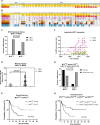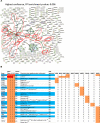Novel molecular subgroups within the context of receptor tyrosine kinase and adhesion signalling in multiple myeloma
- PMID: 33664224
- PMCID: PMC7933144
- DOI: 10.1038/s41408-021-00442-2
Novel molecular subgroups within the context of receptor tyrosine kinase and adhesion signalling in multiple myeloma
Conflict of interest statement
The authors declare no competing interests.
Figures


References
Publication types
MeSH terms
Substances
LinkOut - more resources
Full Text Sources
Other Literature Sources
Medical

